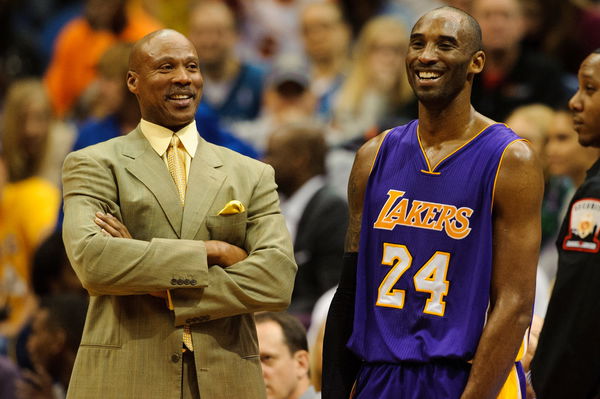
via Getty
MINNEAPOLIS, MN – DECEMBER 14: Byron Scott of the Los Angeles Lakers speaks with Kobe Bryant #24 during a timeout in the fourth quarter of the game against the Minnesota Timberwolves on December 14, 2014 at Target Center in Minneapolis, Minnesota. The Lakers defeated the Timberwolves 100-94. NOTE TO USER: User expressly acknowledges and agrees that, by downloading and or using this Photograph, user is consenting to the terms and conditions of the Getty Images License Agreement. (Photo by Hannah Foslien/Getty Images)

via Getty
MINNEAPOLIS, MN – DECEMBER 14: Byron Scott of the Los Angeles Lakers speaks with Kobe Bryant #24 during a timeout in the fourth quarter of the game against the Minnesota Timberwolves on December 14, 2014 at Target Center in Minneapolis, Minnesota. The Lakers defeated the Timberwolves 100-94. NOTE TO USER: User expressly acknowledges and agrees that, by downloading and or using this Photograph, user is consenting to the terms and conditions of the Getty Images License Agreement. (Photo by Hannah Foslien/Getty Images)
NBA veterans could handle trash talk, late-game daggers, and even soul-crushing Finals losses. But they weren’t ready for Kobe’s 5 AM texts. They weren’t ready for someone who chased greatness like Kobe did. Even legends who once idolized Jordan found themselves begging Kobe to dial it down.
He didn’t.
What separated Kobe wasn’t talent; it was his hunger. He arrived at practice before anyone and left long after they were gone. Teammates told stories of walking into the gym at sunrise only to find Kobe already drenched in sweat. Jay Williams recalls how Kobe once trained an extra 1.5 hours just to prove it, “It doesn’t matter how hard you work. I am willing to work harder than you.”. In Vegas with Team USA, he was up before dawn, icing his knees by breakfast. That wasn’t a show, it was just another Tuesday for him. Kobe didn’t need motivation; he was motivation.
ADVERTISEMENT
Article continues below this ad
On a recent Fast Break episode, designer Jeff Hamilton reflected on Kobe’s deep bond with Michael Jordan. “I never realized Kobe and Michael were so close,” he said. “It warmed my heart when I saw Michael speak about him the way he did.” Hamilton also shared how Kobe’s passion and determination reminded him of Jordan’s early days. “He wore the Jordan jersey, the overshirt—he admired him, and still became his own legend.” That connection between two greats wasn’t about imitation but rather about a shared hunger for greatness.

via Imago
Kobe Bryant Championship picture
Byron Scott, who coached Kobe, followed with a story that showed how obsessed Kobe was with improvement. “He called me at 5 in the morning to ask about practice,” Scott recalled, laughing. “I said, ‘Don’t call me again at 5:00. I don’t get up till 6:00.’” Kobe respected it, but barely. “Then he started calling me at six. ‘Coach, what we doing today?’” Scott joked, “You’re doing nothing—don’t come today.” That was Kobe. Always planning, always pushing, even before sunrise. And while Michael Jordan certainly didn’t mind getting on a call with him so early in the morning, Scott had his priorities straight- don’t call before 6 a.m.!
Kobe Bryant’s growth beyond the shot from the simple “No”
When we think of Kobe Bryant, we picture fadeaways, buzzer-beaters, and his elite scoring talent. Passing? Not so much. Kobe built his legend by attacking, not by dishing out assists. Yet, even then, he averaged 4.7 assists per game: no small feat for someone not playing point guard. Still, many fans felt Kobe believed the best path to victory was keeping the ball in his hands. And often, he wasn’t wrong.
In Three-Ring Circus, author Jeff Pearlman dives deep into the Kobe-Shaq-Phil Lakers era. The book gives us more than just game stats: it explores the people behind the jerseys. Pearlman traced Kobe’s early days in Italy, where his father, Joe “Jellybean” Bryant, played pro basketball. Even then, Kobe’s game revolved around control. Kids would shout at him, “Kobe passa la palla!” (Kobe, pass the ball!), to which he’d simply reply, “No.”
That small word followed Kobe into the NBA. He wanted greatness and thought he had to take it himself. Yet, over time, something shifted. Kobe once said if he hadn’t played alongside Shaq, “My numbers would have been ridiculous.” But would the trophies have followed? Probably not. Learning to trust teammates helped him beat Boston years later, thanks to a clutch pass to Ron Artest.
Like Michael Jordan before him, Kobe eventually realized that scoring less could mean winning more. Without that growth, he might have ended up just another high-scorer with nothing to show. Instead, by learning to share the ball on his terms, Kobe etched his name into history.
The 60-point farewell, the leather jacket by Jeff Hamilton, the ovation – they were proof that the work worked.
From yelling coaches out of sleep to learning when not to shoot, Kobe mutated the blueprint. And in doing so, he didn’t just win rings. He redefined what chasing greatness could look like.
Even if it meant waking up the world before sunrise.
ADVERTISEMENT
Article continues below this ad
ADVERTISEMENT
Article continues below this ad
ADVERTISEMENT
ADVERTISEMENT
ADVERTISEMENT
ADVERTISEMENT

